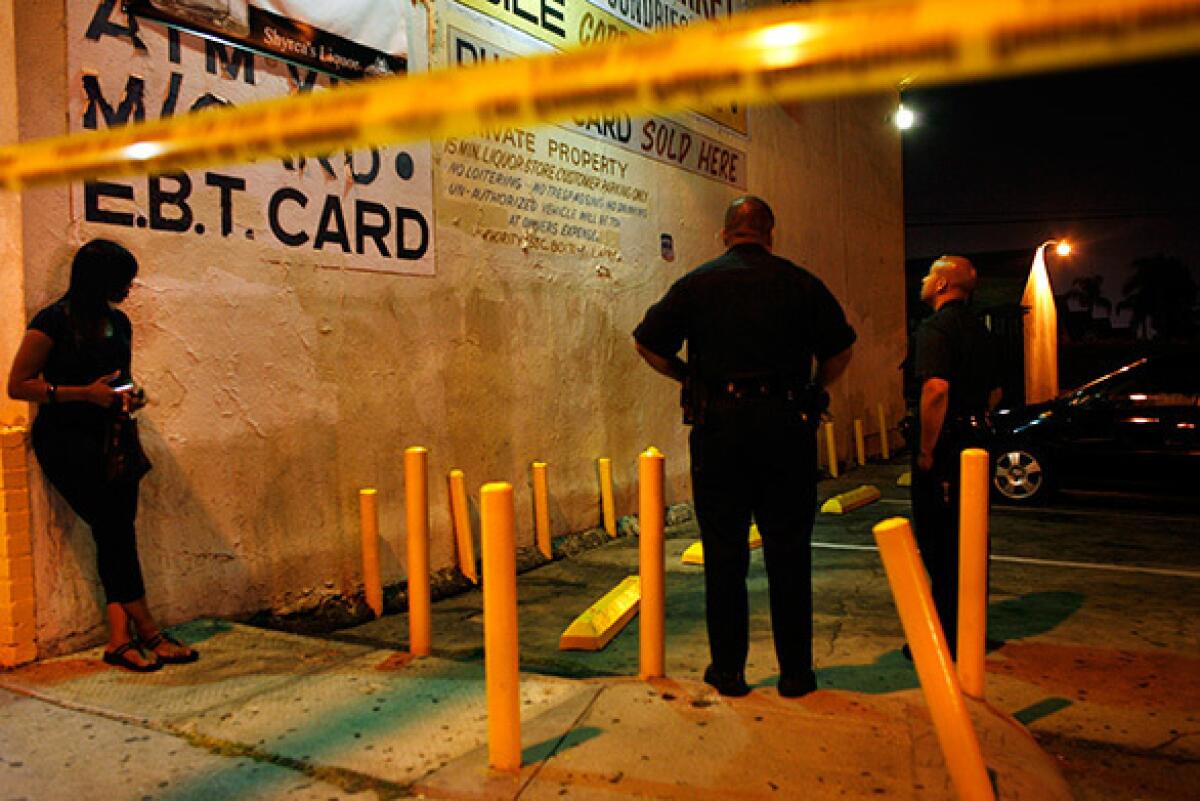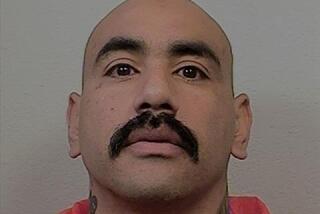A gang feud’s fallout

- Share via
It began, as mortal disputes sometimes do in South Los Angeles, over a girl.
On one side were the Main Street Crips, one of the more muscular gangs in the neighborhood. Main Streeters commanded respect, if only because they had a bit of money to throw around, even their own small record label. On the other side were the Hoover Criminals. The Hoovers were big, with turf that stretched from Vernon Avenue down past Century Boulevard and into “the hundreds,” as the streets are known locally. The Hoovers were belligerent too; they seemed to have a hard time getting along with anybody -- except the Main Street Crips.
Over the years, the two gangs had carved up one patch of South L.A., settling on Broadway as their loose border -- Main Street Crips to the east, Hoovers to the west. Partly because of old friendships, partly because their alliance was good for business, they had coexisted that way for as long as anyone could remember.
Then, one balmy night in August, Main Street threw a party. The Hoovers were invited. The details are murky -- something about a girlfriend and a racy remark -- but it doesn’t matter now. Guns were pulled. Shots were fired. And an old-fashioned beef, the likes of which this part of South L.A. hadn’t seen in several years, was underway.
There have been at least six shootings in the wake of that night. Three people are dead, including a seventh-grader, gunned down on Broadway after buying balloons at a swap meet.
“It’s frightening how something so trivial can set this off,” said Sgt. Dan Horan, who supervises gang operations in the LAPD’s 77th Street Division, one of two police districts that encompass the gangs’ traditional territories.
No one is sure how it’s going to end, and the dispute threatens to undermine the marked progress that has been made here. The LAPD’s intelligence from the streets, said Lt. Michael Carodine, who helps direct anti-gang operations, boils down to this: “It’s on. And it’s not going to be over until it’s over.”
Many residents, civic leaders and city officials believe South L.A. is at a crossroads in part because violent crime has fallen so sharply.
A reduction in gang violence has led the way. The LAPD’s Southeast Division, for instance -- 10 square miles containing 66 gangs, and another district affected by the dispute -- averaged about 140 homicides per year in the late 1980s and early ‘90s, when violence peaked. Officials said they expect to finish 2009 somewhere in the 50s.
Killing up close
That’s why this dispute is so unsettling to police and local officials. It was once routine for gangs to duel openly, but that’s less common these days; relatively few shots are fired solely to retaliate for previous shootings. Worse, the Hoover-Main Street dispute is considered perhaps the most ominous aspect of a broader spike in killings across South L.A. this summer, police said.
In July and August, the police divisions that patrol most of South L.A. recorded 40 homicides, double the rate from the beginning of the year. On Aug. 25, Mayor Antonio Villaraigosa and Police Chief William J. Bratton announced that they had created a multi-agency task force to deal with the rise in violence.
Hours later, at 8 o’clock that night, a gunman walked into the heart of Main Street Crip territory, on Main Street itself, and shot Drayvon James, 29, and Robert Nelson, 16. The double homicide, which has not been solved, is considered one of the incidents that might be linked to the Hoover-Main Street dispute, police said.
“For this guy to do this on foot, up close and personal . . . “ Carodine said, shaking his head. “This is something we haven’t seen in a long time.”
But it was the shooting death of 13-year-old Daquawn Allen that seems to have shaken the neighborhood to its core.
Daquawn’s shooting illustrates the complexities of policing the gangs of South Los Angeles.
He was not a gangbanger, according to police and his relatives. But he was born in Hoover Criminals territory, just west of Broadway. He never knew his father. When he was 9, his mother was sent to prison, and he moved in with his grandmother. Her house was just a few blocks away -- but they were an important few blocks, on the other side of Broadway.
Daquawn had an easy, impish smile and was well-liked. In private, he was terribly upset that he had never met his father, said his grandmother, 54-year-old Linda Allen. He was desperate for male attention and affection, she said, and he found it to some degree with a “set” of Hoovers -- part of the larger umbrella gang -- called the 94 Hoovers, sometimes spelled “9-Foe” and named after West 94th Street.
They even gave Daquawn a street name: Four Star.
Allen refused to use it. “I told him: ‘You use the name your momma gave you,’ ” she said recently on the porch of her home.
A brotherhood
To Daquawn, the Hoovers weren’t a criminal enterprise but a social network, a brotherhood, Allen said. She pulled with all her might in the other direction. “But kids don’t listen,” she said. “They think they know more than you.”
On Aug. 16, the day after the squabble at the party, Daquawn walked with a friend to a swap meet. On their way home, at 12:20 in the afternoon, in front of a hair salon and a cellphone shop on Broadway, a gunman shot Daquawn twice in the torso with a semiautomatic pistol. Allen heard the shots from her living room.
She said she knows the public might lump Daquawn in with the gang, might see him as no different from the gang’s active criminals.
“People say: ‘Well, he got what he deserved.’ But this is family to me. And it hurts,” she said.
“This is the worst it’s been for a long time.”
On Aug. 28, the LAPD arrested 21-year-old Kristopher Thomas in Daquawn’s killing. Thomas has been charged with one count of murder and is being held on $1.5-million bail, authorities said Thursday. Thomas has pleaded not guilty and is next due in court on Oct. 1, said Keith Bowman, a private defense attorney retained by Thomas’ family. Bowman declined to discuss the case.
Thomas, police said, is a Main Street Crip.
But some who work in the community to reduce gang violence -- outside of law enforcement -- say even that part of the story is not as tidy as it might sound.
Robbie Warren, 39, is a former Hoover who served two prison terms for robbery. She is also a founder of a group called Advocates for Peace and Urban Unity, which combats gang violence in South Los Angeles. Warren has worked with Hoovers and Main Streeters in an attempt to reduce the tension, and she said the killing was not a gang-sanctioned act but the work of a misguided gang member acting as a lone wolf.
“You don’t get stripes for killing a child,” Warren said.
And, Warren said, it is possible that other gangs have contributed to the neighborhood’s recent violence.
“Broadway is a big street. You have all kinds of gangs going up and down there,” Warren said. “There is no telling who is coming in.”
Focus on the tension
Police say they will continue to focus on what they believe is the heart of the matter: the tension between the Hoovers and Main Streeters.
The task force created to combat the increased violence has flooded the area with officers -- on some nights, as many as 100 in a densely populated area. The message has been heeded by both gangs, who have gone underground, even if police do not believe they have resolved their dispute.
The 94 Hoovers even decided to make themselves scarce for their “Hood Day,” an annual celebration in which gangs match the street that gives them their name with a date on the calendar -- in this case 9/4, or Sept. 4. Instead of throwing a party in the neighborhood -- inviting scrutiny and possible violence -- the gang decided to spend the day at a safe distance, at Cabrillo Beach, said LAPD gang Officer Michael Knoke.
“They know that the heat is on,” Knoke said.
The evening after the Hoovers’ Hood Day, Knoke; his partner, Officer Jose Gasca; and an anti-gang operations supervisor, Sgt. Randy Goens, went out in search of trouble.
Near 89th Street and Broadway, a stone’s throw from where Daquawn was killed, they turned off their squad cars’ lights and floored it down a forbidding alley full of abandoned couches and tires. They emerged at a spot that is usually a major hangout for 94 Hoovers. It was a Saturday night, and there was not a soul to be found.
“Normally, this is like an apple orchard back here; you can just take your pick,” Goens said as he flicked his lights back on and cruised into the night, to the next spot.
More to Read
Sign up for Essential California
The most important California stories and recommendations in your inbox every morning.
You may occasionally receive promotional content from the Los Angeles Times.











